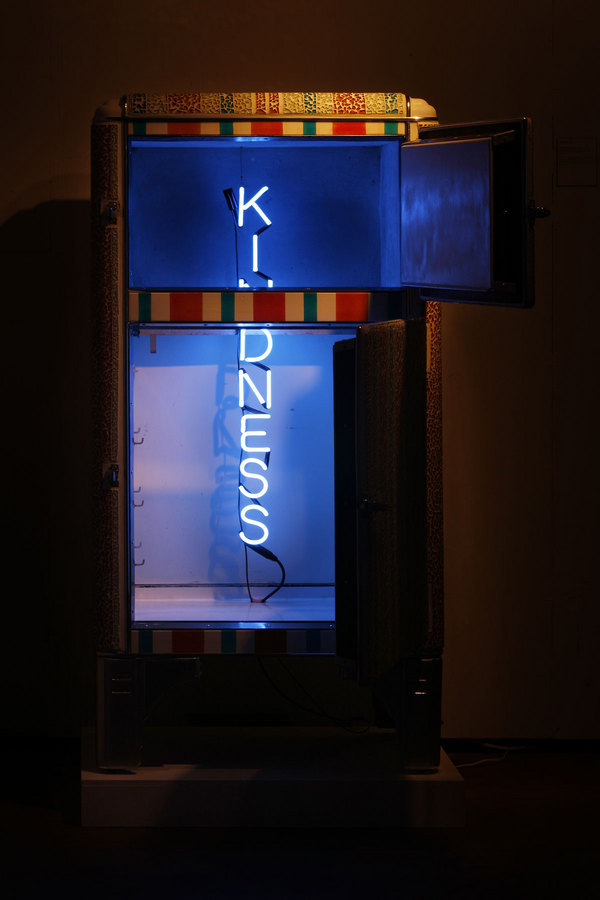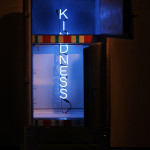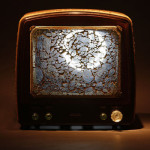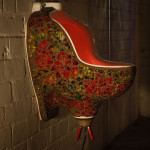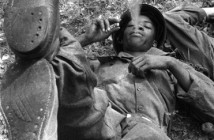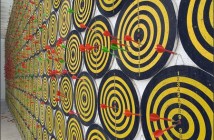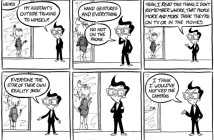AN INTERVIEW WITH MO RINGEY
Jess T. Dugan: Could you speak about the work you are currently making and how you began making it? What significance does the glass itself hold?
Mo Ringey: For the past several years, I have been working on my retro "glass upholstery" pieces which are about transformation and retrospection. The series started with a single fridge which I found in the Arts & Industry building in Florence, MA, where I had a studio. Once I finished the fridge and it went out to galleries, a random parade of people – many of them strangers - began dropping off assorted old appliances at my studio and so a series began of it's own direction.
The glass, as medium, came about when my car window was smashed in front of my apartment in Boston years ago. I picked up all of the pieces, determined to make something of them and started experimenting by making vases and tables. I was mostly painting at that time and would often paint on discarded windows and various flat surfaces found on the side of the road. For me using found objects, and particularly using the glass from my own window, seems about coincidental opportunity, from inconvenient or even tragic circumstance. In that way it seems a metaphor for life, as in a transformation spurred by loss, tragedy, breakage.
JTD: How do you select an object to work with?
MR: So many objects appear at my door and they hang around till one day it seems that now is the time to begin the vacuum cleaner or the ironing board or whatever comes to mind. At some point a project begins to form as a concept and I will look around my studio to see what I have. Sometimes I will go out in search of an object and usually after telling a few people what I am looking for, it will appear.
JTD: Many of the objects you use are taken from the domestic sphere, such as an old washing machine, a refrigerator, an ironing board, etc. But, you seem critical of the traditional gender roles associated with these objects and the ways in which they were once used. Can you speak about how you are challenging these roles and ways of life through your sculpture?
MR: A lot of these old objects were devised for use nearly exclusively by women, yet obviously were designed by men, so they sport a masculine aesthetic, which speaks volumes. I don't think a lot of women were designing and engineering appliances in those eras and I don't know that the men creating them ever used them outside of the workplace or test lab. To an extent – depending on the era - these objects delineate the boundaries of womens' vocational possibilities. Had a woman in the 40's announced to her husband that not only was she not going to iron the family's clothing any longer, but further she was going to spend a hundred hours gluing little bits of smashed glass to the ironing board, thus rendering it useless, she'd have been committed for some sort of feminine Disturbia. But I can do that and go one further and put these things on pedestals. I suppose I have issues with how things were.
JTD: Can you talk a little bit about your studio practice and the process between an idea and a finished piece?
MR: Once I have a project in mind and can see the pattern I want to use for the upholstery, I will sketch it out. I get these huge sheets of glass from a glass company in Holyoke, so one sheet will usually be sufficient for a project. I'll drag the glass out to the alley outside my studio and start staining it in blocks of the colors I need for that piece. Then I will smash it. This step is dictated by the size of the glass. If it fits on a work table then I will wrap it up in heavy plastic and lay it flat on the table and smash it. But if it is a large piece – like 4 x 5 feet, I will lay it out in the alley on a bunch of pieces of plywood and smash it and then transfer the glass to boxes by color.
If I am working on an appliance which is metal, I will clean it up first to remove any rust and then prime it. I use a lot of automotive products.
I will often use a grease pencil to draw out the pattern on the appliance, with colors written on little pieces of tape for geometric patterns, and start gluing. I use a restoration glaze with a high tensile strength and an adjustable viscosity (depending on how I mix it) as an adhesive. This requires a double-barreled respirator. I mostly work in the alley and keep my projects on carts with industrial wheels. After the endless gluing, I will grout the piece using a sanded floor grout. And then gild or add neon as the piece dictates.
JTD: Can you speak about the intersection of nostalgia and problematic social conditions? In some pieces, such as the refrigerator that you fill with kindness and pattern in color similar to those of your grandfather's pajamas, you seem to be remembering a time from the past with fond memories. However, in your ironing board piece, you state that you want the viewer to see themselves reflected in an unflattering, unhappy light to mimic how a housewife might feel with endless piles of wrinkled clothes to iron. Where do these two possibly contradictory histories meet for you?
MR: But we know that's not true; maybe it was escapism? I mean, could things really have been less complicated, ever? I suppose that trumpeting kindness by spelling it out in neon and putting it on ice, so to speak, might be hinting at my opinion regarding the current state of human behavior and the need for preservation of more civil concepts such as kindness and truth. I don't know if life was truly simpler in the past, and kindness and truth were once more prevalent. But when I think of that era in terms of aesthetics, customs, and manners, I do imagine a simpler and kinder standard of civility. It seems that a lot of "lightness of being" might go into a Jello mold, or a Harvey Wallbanger.
JTD: How did your urinal piece come about? Is it intended to be in dialogue with such ideas as the ready-made, from an art history point of view, or in dialogue with issues of gender and masculinity, from a social point of view? Or did you just like it?
MR: When I moved to my present studio in Holyoke, it was sitting on the windowsill, like a cat looking out. The landlord kept saying he would take it to the basement but never did so it just stayed there. Then one day a psychic in Michigan emailed me and said she had seen my website and that she had a vision that I should do a urinal. Being squeamish about tempting fate, and having this urinal sitting in the sun, I went at it. I added the single red light bulb because it looked so bleak with nothing in it, and I wanted a different, morecarnivalesque sort of bleak.
I was conscious all along of the possibility of having to answer for possibly copying Duchamp, but I wanted to start with a very masculine object and that seemed an obvious place to begin. It is actually dated, as if it is a work in and of itself; it's a '67. None of the appliances I have are dated. And it does look so much like Duchamp's urinal in its original form.
JTD: I am also fascinated that you chose to fill the bag with only good things, such as arts listings and local events. Do you feel that the objects you work with have an inherent energy of their own? If so, how does that influence your process?
MR: When it does happen that an object has a will of its own, I can do contortions and yet cannot attain my aesthetic goal, and so I think they do have an inherent will. I had planned a circus-like effect and somehow they turned out – through odd chemical reactions and unexplained occurrences – with a more Parisian-Chinois sort of look. I fought them at every turn and they won. Now, I give in at the start if there seems to be a will, wondering why an object seems to be imbued with determination.
JTD: Which artists do you look at for inspiration? Where else do you find inspiration?
MR: I find a lot of inspiration in my grandmother's 1943 Joys of Jello cookbook. I am also much influenced by the crackelure of the Song Dynasty, Gustav Klimt, Vincent Van Gogh, and, yes, Marcel Duchamp.
JTD: What's next? What do you plan to make in the future?
MR: I am working on a project for an old single screen theater in Springfield called The Bing, after Bing Crosby, which opened in 1950, closed in 1999, and is being transformed to an arts center. I took an old row of seats and am mosaicing the cloth parts, because that also does not make much sense and it's the largest area to work with. I chose the last row in the darkest corner and I call it The Make Out Row. It even came with a piece of gum stuck under the seat, which I am going to gild.
- Mo Ringey, Coolerator, Philco Color Television, Tempered Glass, Glass Stains, Sanded Grout, Acid Stains, Glass Doorknobs, Neon, Mirror, 2005.
- Mo Ringey, Narcissivision, Philco Color Television, Tempered Glass, Glass Stains, Sanded Grout, Acid Stains, Glass Doorknobs, Neon, Mirror, 2005.
- Mo Ringey, Urinal, Tempered Glass, Stain, Sanded Grout, 2007

